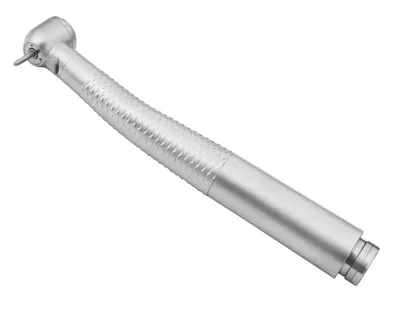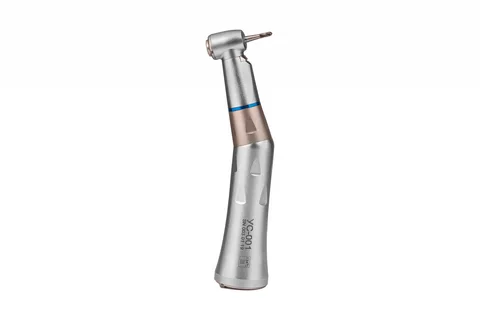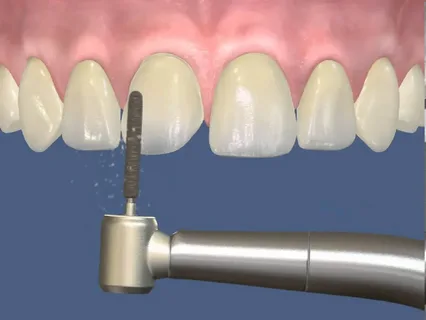Dental Dissection Tools
Machine translation
Original article is written in RU language (link to read it) .
To rotate the bur in turbine tips, a flow of pressurized air is used, which provides the rotation of the rotor, which is located directly in the tip itself, in its head. A distinctive feature of the turbine tip is its ability to rotate the tool at high speeds (over 250,000 revolutions per minute). If low speeds are required, preference should be given to micromotor tips.
Learn more about diamond burs and preparation techniques at the webinar Vertical Preparation/Stepless Preparation - Back to the Future?!.
The rotation of the bur in micromotor tips is due to the presence of a complex system consisting of the following components:
reducers,
shafts,
transmission gears, which serve to convert the motion of the shaft,
an electric or pneumatic motor.

Figure 1. Turbine dental handpiece.
The motor handpiece is attached to an air (pneumatic) or electric micromotor, which powers it.
In addition to the three-component rotary system, there is also a two-component system, where the handpiece and the air micromotor are integrated. The latter is connected with a multiflex connection, which is used for the turbine handpiece.
If we compare turbine and micromotor handpieces, the latter have greater power during the cutting process of the surface treated with a bur. Also, in micromotor handpieces, it is possible to adjust the rotation speed of the tool without reducing power.
Classifications of Handpieces
Micromotor handpieces, depending on the method of converting rotation speed, are divided into the following types:
handpieces equipped with blue marking, in which the transmission of rotation occurs without changing the speed;
reducing handpieces, have green marking, in which the transmission of rotation occurs with a reduction in speed;
increasing handpieces, marked with red marking, in which the transmission of rotation occurs by increasing the speed.

Figure 2. Angular dental handpiece.
Micromotor handpieces, depending on the design features, come in two types:
angular (the axis of the bur is at an angle to the longitudinal axis of the handpiece),
straight (the axis of the bur coincides with the axis of the handpiece).
Micromotor handpieces are capable of providing complete and reciprocal rotation of the bur around its longitudinal axis. The tool performs reciprocating clockwise and counterclockwise rotations during reciprocal movement.
Tools
The scraping or cutting action of full-rotation machine tools is provided by the work of abrasive grains or metal blades on the treated surface.
Examples of rotary tools include:
metal tools, made from metal alloys, their working surfaces equipped with notches in the form of blades, special cuts, or other design features (carbide and steel burs, drills, mills, endodontic treatment tools);
abrasive tools, made from abrasive grains, which are bonded together by a binding material (wheels, discs, heads);
special devices for performing professional oral hygiene, grinding and polishing teeth and restorations (felts, brushes).
Rotary tools are divided into grinding tools, which provide initial surface cleanliness levels, and polishing or finishing tools, which ensure a high level of surface cleanliness, depending on the cleanliness created during preparation.
To ensure high-quality treatment and prevent complications, it is important to properly select rotary tools and use them adequately at each stage of treatment.
The choice of tool is determined by the following characteristics:
the hardness of the surfaces being processed;
specifics of the operating mode, which are determined by the functional tasks and the type of surgical method;
economic efficiency (cost, durability, productivity).
The effectiveness of preparation is predominantly influenced by the hardness of the surfaces being processed and the hardness of the materials from which the rotary tools are made.

Figure 3. Tooth preparation using a rotary tool.
Diamond and carbide tools are versatile. However, it is important to consider their tendency to have the working surface of the bur clogged by debris, especially during the preparation of cement or dentin with diamond heads.
Operating Mode
The operating mode with rotary tools involves a combination of the following factors:
rotation speed,
pressure transmitted to the surface being prepared,
cooling method used during the process.
Rotation Speed
The speed of preparation is determined by the type of surface being prepared, the tasks being solved, and the choice of tools. At any stage of preparing a carious cavity, strictly defined tools are needed, rotating at various speeds, it is only important to strictly follow the recommendations for each type of rotary tools regarding the permissible number of revolutions.
The doctor should not forget that the high speed of the drill movement and relatively high pressure contribute to significant heat generation, which can negatively affect the viability of the pulp. The initial stage of cavity preparation away from the pulp chamber, in the enamel area, is carried out at ultra-high and high speed ranges, while edge finishing or preparation near the pulp is done in medium and low ranges.
Pressure on the Tool
During the dissection of tooth tissues or other surfaces, controlled pressure must be applied to the dental instrument. However, the amount of pressure should be strictly measured; it is determined by the conditions of work and the type of instrument chosen. Even a slight increase in pressure can cause excessive friction heat, which may lead to thermal burns of the vascular-nerve bundle located in the pulp chamber of the tooth. For this reason, significant efforts should not be applied, especially when working with tools for a turbine handpiece.

Figure 4. Tool for turbine tip.
Instructions from most manufacturers recommend using a non-forced, intermittent type of operation, which also ensures an increase in the service life of the tools. The literature provides indicators of optimal pressure of rotary tools on the surface considering the type of tool, its affiliation to the tip, and the grit of the abrasive.
Cooling
During preparation, kinetic energy is generated, which is transferred by the tool to the tooth. This energy is the cause of heating the treated surface – tooth tissues. Only the use of effective cooling during preparation serves as a prevention of forming a high-temperature focus on the treated surface. The degree of temperature increase in dentin depends on the duration of operation and the applied cooling. The most effective types of cooling include:
water-based,
air-water.
Preparation in dentistry involves working on surfaces with complex configurations, solving various functional problems:
drilling,
cutting,
grinding,
polishing.

Figure 5. Dissection with cooling.
Choosing the Tool
The quality and result of the dissection are primarily determined by the correct choice of the rotary tool suitable for a specific stage of dissection. The accuracy of tool selection depends on the doctor's experience, the specifics of working with the tools developed during practical activity.
It is important to follow the manufacturer's recommendations on the functional purpose of the specific tool, especially at the beginning of a professional's career. These recommendations take into account the material of the working part of the tool, its size and shape, the area of application, and indications for use.
Some Examples
Carbide spherical bur – for the preparation of enamel and dentin.
Spherical diamond head – for opening and subsequent expansion of the cavity, can also be used for adjusting the occlusal surface.
Cylindrical burs - fissure opening, excision of overhanging edges above the cavity, creation of an occlusal step, cervical step, flat bottom.
Conical tools – for preparing a tooth for an artificial crown, creating diverging walls, fissure opening, forming a step in the cervical area.
Tools in the shape of an inverted or reverse cone – forming retention points, contouring walls, preparing the occlusal surface.
For more current information on this topic, visit the webinar Vertical Preparation: Evolution of the Technique.

/public-service/media/default/430/DxsI5_671a145105a71.jpeg)
/public-service/media/default/431/gortG_671a1464675a1.jpeg)
/public-service/media/default/427/kGS1A_671a139147732.png)